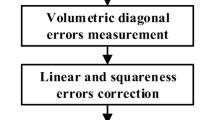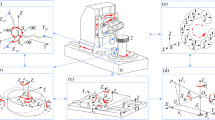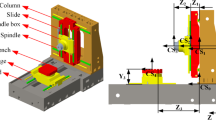Abstract
This paper proposes a new method to identify the squareness errors of machine tools and gives an optimal method to improve the volumetric compensation accuracy based on the identified squareness errors. The volumetric error model based on screw theory is proposed and the effects of the squareness errors on the volumetric errors have been analyzed to clarify the possibility of improving volumetric error compensation by proper and accurate squareness errors. Then the identification method of the squareness errors is deduced in theory considering a 3-axis horizontal machine tool. With the identified squareness errors, an optimal method to improve volumetric error compensation in machine tools has been proposed. Experiments have verified that the 3 identified squareness errors are in accordance with the measured squareness errors within the accuracy range. Moreover, compared with the traditional measurement of squareness errors not considering the PDGEs, the proposed method is more effective and shows error compensation improvement in the volumetric error compensation process.













Similar content being viewed by others
Abbreviations
- \( x,y,z \) :
-
Motion commands of X-, Y- and Z-axis
- \( \hat{\xi }_{i} \) :
-
Motion twist for the i-axis \( (i = {\text{X,}}\,{\text{Y,}}\,{\text{Z)}} \)
- \( \delta_{ij} \) :
-
Translational error of the j-axis in the i direction \( (i,j = {\text{X,}}\,{\text{Y,}}\,{\text{Z)}} \)
- \( \varepsilon_{ij} \) :
-
Rotational error of the j-axis in the i direction \( (i,j = {\text{X,}}\,{\text{Y,}}\,{\text{Z)}} \)
- \( S_{ij} \) :
-
Squareness error of the j-axis relative to the i-axis \( (i = X,\;j = {\text{Y,Z}}\;{\text{or}}\;i = Y,\;j = {\text{Z)}} \)
- \( g_{bj}^{k} (0) \) :
-
HTM of tool \( (j = {\text{t)}} \) or worktable \( (j = {\text{w)}} \) coordinate frame relative to base coordinate frame in the reference configuration in actual \( (k = {\text{a)}} \) or ideal \( (k = {\text{i)}} \) condition
- \( g_{ij}^{k} \) :
-
HTM of tool \( (j = {\text{t)}} \) or worktable \( (j = {\text{w)}} \) coordinate frame relative to base \( (i = {\text{b)}} \) or worktable \( (i = {\text{w)}} \) coordinate frame in actual \( (k = {\text{a)}} \) or ideal \( (k = {\text{i)}} \) condition
- \( \Delta i \) :
-
Geometric errors of the i-aixs \( (i = {\text{X,}}\,{\text{Y,}}\,{\text{Z)}} \)
- \( p_{0} \) :
-
The homogeneous coordinate of the point on the tool relative to the tool frame \( p_{0} = (0,\;0,\;0,\;1)^{T} \)
- \( (x_{t0} ,\;y_{t0} ,\;z_{t0} ) \) :
-
The coordinate of the initial investigated point on the tool relative to the tool coordinate frame
- \( (x_{i0} ,\;y_{i0} ,\;z_{i0} ) \) :
-
The coordinate of initial rotation center point of error screw motion of X-, Y- and Z-axis \( (i = 1 ,\; 2 ,\; 3 ) \)
- \( S_{Vji} \) :
-
Global sensitivity coefficient of the error parameter in x, y and z direction in the global workspace, i is the number of geometric error parameter shown in Table 1\( (j = {\text{X,}}\;{\text{Y,}}\;{\text{Z,}}\;\;{\text{i}} = 1 , 2 ,\ldots , 2 1 ) \)
- \( e_{i} \) :
-
Geometric error parameter with the symbol i representing the number of geometric error parameters as shown in Table 1
- \( (e_{x1di} ,\;e_{y1di} ,\;e_{z1di} ) \) :
-
The volumetric error of the first body diagonal line at point i \( (i = 1,2, \ldots ,n ) \)
- \( (x_{ul1} ,\;y_{ul1} ,\;z_{ul1} ) \) :
-
The unit vector of the moving direction of the first body diagonal line
References
Ramesh, R., Mannan, M. A., & Poo, A. N. (2000). Error compensation in machine tools—A review: Part I: geometric, cutting-force induced and fixture-dependent errors. International Journal of Machine Tools and Manufacture, 40, 1235–1256.
Lee, K., & Yang, S. (2013). Measurement and verification of position-independent geometric errors of a five-axis machine tool using a double ball-bar. International Journal of Machine Tools and Manufacture, 70, 45–52.
Zhao, L., Chen, H., Yao, Y., & Diao, G. (2016). A new approach to improving the machining precision based on dynamic sensitivity analysis. International Journal of Machine Tools and Manufacture, 102, 9–21.
Park, D., Lee, G., Gao, J., & Kim, J. (2016). Research on the design of the ultra-high-precision positioning control error compensation. International Journal of Precision Engineering and Manufacturing, 17, 1351–1358.
Zhong, G., Wang, C., Yang, S., Zheng, E., & Ge, Y. (2015). Position geometric error modeling, identification and compensation for large 5-axis machining center prototype. International Journal of Machine Tools and Manufacture, 89, 142–150.
Khim, T. S., & Keong, L. C. (2010). Modeling the volumetric errors in calibration of five-axis CNC machine. In International multiconference of engineers and computer scientists (IMECS 2010) (Vol. I–III, pp. 1833–1837).
Zhong, X., Liu, H., Mao, X., Li, B., He, S., & Peng, F. (2018). Volumetric error modeling, identification and compensation based on screw theory for a large multi-axis propeller-measuring machine. Measurement Science & Technology, 29, 055011.
Xiang, S., & Altintas, Y. (2016). Modeling and compensation of volumetric errors for five-axis machine tools. International Journal of Machine Tools and Manufacture, 101, 65–78.
Yang, J., Mayer, J. R. R., & Altintas, Y. (2015). A position independent geometric errors identification and correction method for five-axis serial machines based on screw theory. International Journal of Machine Tools and Manufacture, 95, 52–66.
Yu, Z., Tiemin, L., & Xiaoqiang, T. (2011). Geometric error modeling of machine tools based on screw theory. Procedia Engineering, 24, 845–849.
Schwenke, H., Knapp, W., Haitjema, H., Weckenmann, A., Schmitt, R., & Delbressine, F. (2008). Geometric error measurement and compensation of machines: An update. CIRP Annals Manufacturing Technology, 57, 660–675.
Zhang, G., Ouyang, R., Lu, B., Hocken, R., Veale, R., & Donmez, A. (1988). A displacement method for machine geometry calibration. CIRP Annals Manufacturing Technology, 37, 515–518.
Zhu, S., Ding, G., Qin, S., Lei, J., Zhuang, L., & Yan, K. (2012). Integrated geometric error modeling, identification and compensation of CNC machine tools. International Journal of Machine Tools and Manufacture, 52, 24–29.
Li, J., Xie, F., Liu, X., Li, W., & Zhu, S. (2016). Geometric error identification and compensation of linear axes based on a novel 13-line method. The International Journal of Advanced Manufacturing Technology, 87, 2269–2283.
Lee, J., Lee, H., & Yang, S. (2016). Total measurement of geometric errors of a three-axis machine tool by developing a hybrid technique. International Journal of Precision Engineering and Manufacturing, 17, 427–432.
Lasemi, A., Xue, D., & Gu, P. (2016). Accurate identification and compensation of geometric errors of 5-axis CNC machine tools using double ball bar. Measurement Science and Technology, 27, 055004.
Lee, K., & Yang, S. (2013). Robust measurement method and uncertainty analysis for position-independent geometric errors of a rotary axis using a double ball-bar. International Journal of Precision Engineering and Manufacturing, 14, 231–239.
Ibaraki, S., Oyama, C., & Otsubo, H. (2011). Construction of an error map of rotary axes on a five-axis machining center by static R-test. International Journal of Machine Tools and Manufacture, 51, 190–200.
Lei, W. T., & Hsu, Y. Y. (2003). Error measurement of five-axis CNC machines with 3D probe-ball. Journal of Materials Processing Technology, 139, 127–133.
Ibaraki, S., Iritani, T., & Matsushita, T. (2013). Error map construction for rotary axes on five-axis machine tools by on-the-machine measurement using a touch-trigger probe. International Journal of Machine Tools and Manufacture, 68, 21–29.
Lee, K., Lee, J., & Yang, S. (2018). Optimal On-machine measurement of position-independent geometric errors for rotary axes in five-axis machines with a universal head. International Journal of Precision Engineering and Manufacturing, 19, 545–551.
Schwenke, H., Schmitt, R., Jatzkowski, P., & Warmann, C. (2009). On-the-fly calibration of linear and rotary axes of machine tools and CMMs using a tracking interferometer. CIRP Annals Manufacturing Technology, 58, 477–480.
Zhang, Z. J., & Hu, H. (2013). Three-point method for measuring the geometric error components of linear and rotary axes based on sequential multilateration. Journal of Mechanical Science and Technology, 27, 2801–2811.
Wang, J., Wang, Q., & Li, H. (2019). The method of geometric error measurement of NC machine tool based on the principle of space vector’s direction measurement. International Journal of Precision Engineering and Manufacturing, 20, 511–524.
ISO 230-1 (2012). Test code for machine tool—Part 1: Geometric accuracy of machines operating under no-load or quasi-static conditions.
Yang, S., Lee, H., & Lee, K. (2018). Face- and body-diagonal length tests using a double ball-bar for squareness errors of machine tools. International Journal of Precision Engineering and Manufacturing, 19, 1039–1045.
Murray, R. M., Li, Z., & Sastry, S. S. (1994). A Mathematical Introduction to Robotic Manipulation. Boca Raton: CRC Press.
ISO 230-6 (2002). Test code for machine tools—Part 6: Determination of positioning accuracy on body and face diagonals (diagonal displacement tests).
Acknowledgements
This research was supported by the National Natural Science Fund under Grant Nos. 51775210 and 51775212, and the National Science and Technology Major Project of China under Grant No. 2015ZX04000016.
Author information
Authors and Affiliations
Corresponding author
Additional information
Publisher's Note
Springer Nature remains neutral with regard to jurisdictional claims in published maps and institutional affiliations.
Rights and permissions
About this article
Cite this article
Zhong, X., Liu, H., Mao, X. et al. An Optimal Method for Improving Volumetric Error Compensation in Machine Tools Based on Squareness Error Identification. Int. J. Precis. Eng. Manuf. 20, 1653–1665 (2019). https://doi.org/10.1007/s12541-019-00191-0
Received:
Revised:
Accepted:
Published:
Issue Date:
DOI: https://doi.org/10.1007/s12541-019-00191-0




